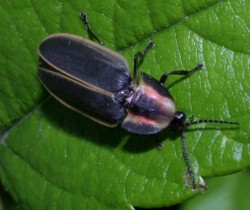
Ever seen little points of light buzzing around outside on summer nights? Those lights – fireflies – are beetles that create light through a chemical reaction. By controlling the reaction, fireflies can turn on and off their lights. They flash light to communicate and find a mate.
Fireflies may be disappearing from some areas where they have been found in the past, so researchers are looking to citizen scientists for help understanding more about what is affecting fireflies.
Changes in the way we use land might be taking a toll on fireflies. For example, as natural landscapes are turned into lawns, fertilizers, pesticides and mowers may jeopardize fireflies, which spend daytime hours on the ground. Fireflies might also be affected by outdoor lights such as streetlights and the amount of water in the environment.
The Firefly Watch project gets the public involved collecting data about where fireflies are found. If you live east of the Rocky Mountains in the United States and have ten minutes a week to look for fireflies in the evening, consider signing up as a volunteer.
The project started three years ago at Boston’s Museum of Science by Don Salvatore, project coordinator, in collaboration with local scientists. Don had been teaching insect programs at the museum and was getting questions from visitors about fireflies. Some people mentioned that they used to see more fireflies years ago and wondered whether fireflies were becoming less common. Don contacted Adam South, a graduate student at Tufts University studying fireflies, and the two of them started Firefly Watch with other researchers in 2008.
In the project’s first summer, Don hoped to get 100 people in the local area to participate. There was much more interest than he expected. Seven hundred people from 34 states watched fireflies with the project during the summer of 2008. Now, three years later, 5000 people have become involved.
Volunteers watch for fireflies at least once per week throughout the warm season. In New England that season is roughly from the end of May until the beginning of August. The season for finding fireflies is much longer further south. For example, in Florida you might be able to find fireflies from March to November.
While Firefly Watch suggests that people look for fireflies in their backyards, mainly because that is convenient for many people, you can choose any spot – urban, rural, or suburban. Because the project is interested in the impact of fertilizers and pesticides on fireflies, choose a spot where you know whether these products are used.
Before you head outside to look for fireflies, register on the website and then check out the Virtual Habitat to learn how to recognize different types of fireflies from their flashing lights and the types of flashing patterns that you may see outside.
If you are not able to watch fireflies where you live, you can still take a look at the data online. There are maps showing where Firefly Watch volunteers have spotted fireflies. You can also download all the data if you’d like to interpret it yourself. The project invites you to explore and analyze the data yourself and then report back what you found. Who knows what interesting trend you may discover in the data!
Check out Don Salvatore’s Blog on Science for Citizens.
This post was originally published on Citizen Science Buzz, a blog on TalkingScience that highlights science projects that are helping us better understand our planet and the Universe.

